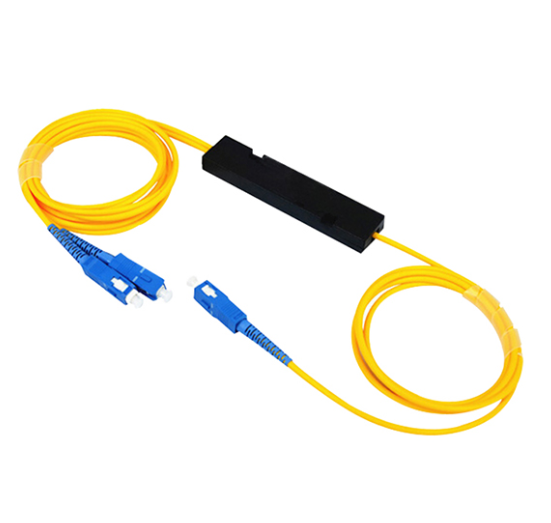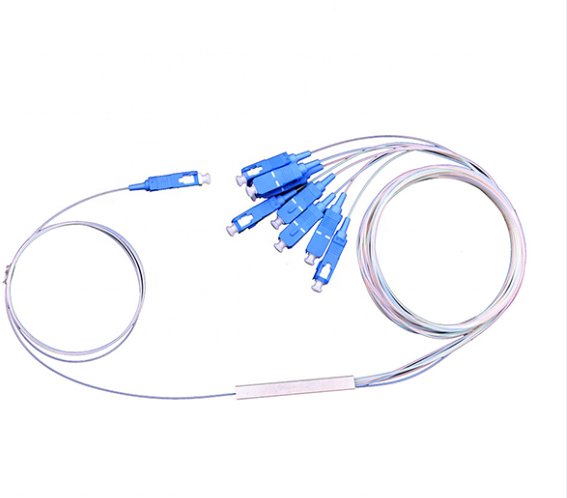In FTTx and PON architectures, optical splitters are playing an increasingly important role in creating a wide variety of point-to-multipoint fiber optic networks. But do you know what a fiber optic splitter is? Indeed, a fiber optic splitter is a passive optical device that can split or separate an incident light beam into two or more light beams. There are basically two types of fiber splitter, which are classified according to their functional principle: Fused Biconical Taper Splitter (FBT Splitter) and Planar Lightwave Circuit Splitter (PLC Splitter). Maybe you have a question: what is the difference between them and should we use FBT or PLC splitter?


What is FBT Splitter?
The FBT splitter is based on a traditional technology for welding multiple fibers together from the side of the fiber. Fibers are aligned to a specific position and length by heating. Since the fused fibers are very fragile, they are protected by a glass tube made from epoxy and quartz powder. And then a stainless steel tube covers the inner glass tube and is sealed with silicone. As technology evolves, the FBT splitters are of very good quality and they can be used inexpensively.
What is a PLC splitter?
The PLC splitter is based on the technology of planar light wave switching. It consists of three layers: a substrate, a waveguide and a lid. The waveguide plays a key role in the splitting process, which enables certain portions of light to pass through. In this way, the signal can be divided evenly. In addition, PLC splitters are available in various split ratios including 1: 4, 1: 8, 1:16, 1:32, 1:64, etc. There are also different types such as: B. Bare PLC Splitter, Blockless PLC Splitter, Fanout PLC Splitter, Mini Plug-in PLC Splitter, etc. Therefore, when a high number of splitters, small package size and low insertion loss are required, it is recommended to use a PLC -Splitter to choose instead of an FBT-Splitter. For more information on the PLC splitter, see How Much Do You Know About PLC Splitters?
FBT vs. PLC splitter
(1) Operating wavelength
The FBT splitter can only support three wavelengths: 850nm, 1310nm and 1550nm, which means that it will not work at other wavelengths. While the PLC splitter can support wavelengths from 1260 to 1650 nm. The adjustable wavelength range makes the PLC splitter suitable for more applications.
(2) Splitting Ratio
The distribution ratio is determined by the inputs and outputs of an optical cable splitter. The maximum split ratio of the FBT splitter is up to 1:32, which means that one or two inputs can be split into a maximum of 32 fibers at the same time as an output. However, the split ratio of the PLC splitter is up to 1:64 - one or two inputs with an output of a maximum of 64 fibers. In addition, the FBT splitter is adaptable and the special types are 1: 3, 1: 7, 1:11, etc. However, the PLC splitter is not adaptable and only has standard versions such as 1: 2, 1: 4, 1: 8, 1:16, 1:32 and so on.
(3) Asymmetrical attenuation per branch
The signal processed by FBT splitters cannot be split evenly due to a lack of signal management, so the transmission distance can be affected. However, the PLC splitter can support the same splitter ratios for all branches, so that it is more stable.
(4) Failure rate
The FBT splitter is typically used for networks that require a splitter configuration of fewer than 4 splits. The larger the division, the greater the failure rate. If the division ratio is greater than 1: 8, more errors occur and cause a higher error rate. The FBT splitter is therefore more limited to the number of splits in a coupling. But the failure rate of the PLC splitter is much lower.
(5) Temperature-dependent loss
In certain areas, the temperature can be a decisive factor that influences the insertion loss of optical components. The FBT splitter can work stably under a temperature of -5 to 75 ° C. The PLC splitter can operate in a wider temperature range of -40 to 85 ℃ and performs relatively well in areas with extreme climatic conditions.
(6) Price
Because of the complicated manufacturing technology of the PLC splitter, its cost is generally higher than that of the FBT splitter. If your application is simple and financially tight, the FBT splitter is definitely an affordable solution.
Conclusion
Although the external appearance and size of FBT and PLC fiber chips appear quite similar, their internal technologies and specifications differ in several ways. In recent years splitter technology has taken a big step forward with the introduction of PLC splitters in recent years. It has proven to be a more reliable type of device compared to the traditional FBT splitter.
Contact: Andy Huang
Phone: 0086-755-89239407
E-mail: sales@beskco.com
Add: No.3106,Longgang Avenue,Pidi Town, Longgang District, Shenzhen China
We chat